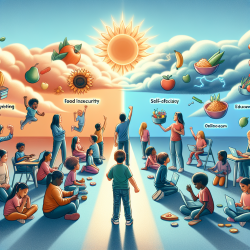Introduction
In the ever-evolving field of speech-language pathology, understanding the intricate connections between mental health, environmental factors, and microbiota is crucial. Recent research, such as the study "Dysbiotic drift: mental health, environmental grey space, and microbiota," highlights the profound impact of microbiota on mental health, particularly in socioeconomically disadvantaged populations. This blog explores how practitioners can leverage these findings to improve mental health outcomes for children, especially those receiving online therapy services from TinyEYE.
The Role of Microbiota in Mental Health
The research underscores the significance of microbiota in influencing mental health. The gut-brain-microbiota axis is a burgeoning area of study, revealing how non-pathogenic microbes can affect mood, cognition, and behavior. This connection is particularly relevant for children, as early interventions can shape their mental health trajectories.
Environmental and Socioeconomic Factors
The study highlights the disparity in microbiota diversity among socioeconomically disadvantaged populations. Environmental grey spaces, characterized by limited access to green spaces and healthy food options, contribute to a state of dysbiosis. This imbalance in microbiota can exacerbate mental health issues, making it imperative for practitioners to consider these factors when designing interventions.
Implications for Practitioners
Practitioners can enhance their skills by integrating these insights into their practice. Here are some actionable steps:
- Promote Healthy Nutrition: Encourage families to incorporate a diverse range of fruits, vegetables, and fermented foods into their diets. These foods can enhance microbiota diversity and support mental health.
- Advocate for Green Spaces: Advocate for increased access to green spaces in communities. Exposure to natural environments can reduce stress and improve mental well-being.
- Address Socioeconomic Barriers: Work with schools and communities to address socioeconomic barriers that limit access to healthy food and environments. Collaborative efforts can create supportive ecosystems for children.
Encouraging Further Research
While the current research provides valuable insights, there is a need for further exploration. Practitioners are encouraged to stay informed about emerging studies on the gut-brain-microbiota axis and its implications for mental health. By fostering a culture of continuous learning, practitioners can remain at the forefront of providing effective interventions.
Conclusion
The intersection of microbiota, mental health, and environmental factors presents a promising avenue for improving outcomes for children. By integrating these insights into practice, practitioners can contribute to a holistic approach that addresses the root causes of mental health disparities. To read the original research paper, please follow this link: Dysbiotic drift: mental health, environmental grey space, and microbiota.










